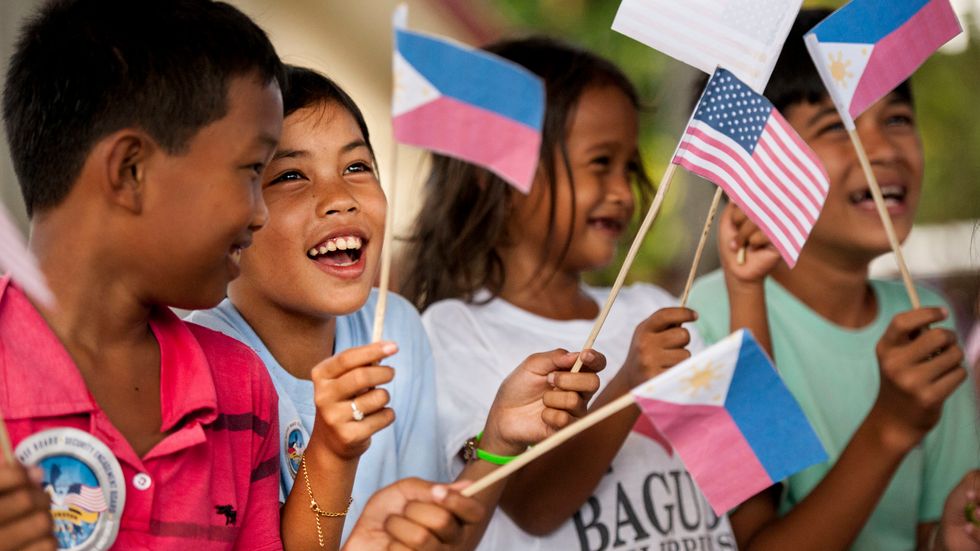My Lola (grandmother in Tagalog) taught me many lessons in life, such as the importance of family, how to be strong, and how to put others before myself. Through these many lessons one, in particular, stands out to me that influences my daily actions and my core values. It was how to be proud of my Filipino heritage in a world where immigrants are constantly being subdued.
My mother is of Irish/Polish descent, while my father’s parents both came to America from the Philippines. This classifies me as Pacific Islander/Asian. While this may be the category I fall into in the means of ethnicity, I am often asked if I am Hispanic or if I speak Spanish due to my long, dark hair and my tan skin.
I have received Hispanic related comments about my ethnicity since I was a young girl and it has always surprised me how people ask me this question without reservation, even in a professional setting. As I got older and the issue of immigration became thrust more into the spotlight with recent political and news events, I grew accustomed to racial slurs being thrown at me. These slurs were not in the historical racist fashion that was fueled by hate, but they were more so formed as ‘jokes’ that peers would find funny.
I had heard it all, “take that Mexican back to where she came from," “put her back over on her side of the wall," and “how did your quinceañera go?” I even had my Spanish teacher ask me why I didn’t know the language if I spoke it at home, even though I live in a home that only speaks English and Spanish is in fact not the native tongue of the Philippines.
I reached a point where I was accustom to people assuming I was Hispanic. It even became a running joke to some of my friends. While it may have seemed to come off humorous, in the back of my mind I knew I was hurt by their words. I was embarrassed by the comments my ethnicity brought up. I am an interesting breed, “a mutt” as someone once referred to me as, since I was not fully Asian nor white. This left me confused as to what identify and what “stereotype” I fell under — and why I had to fall under one at all.
Then, when I went up to visit my Lola in middle school and told her about the stigma I sometimes felt towards my racial identity, she gave me a soft smile and held me close as she gave me the advice that I had been craving.
She told me first of her life as a little girl growing up in the Philippines. She painted the image of a densely packed little village in the steamy overgrown rainforest and her as a poor girl looking for something that would change her life and get her out of poverty. After hard work and determination, she graduated from nursing school and met my Papa, who was in school to practice becoming a surgeon.
They fell in love quickly and were married after he graduated. After settling into the married life they searched for a better life, which led them to move to America to practice medicine and nursing where they could be better off.
My Lola spoke of the fear that struck her as she was moving halfway across the world with no family, very little money, and only her dreams of a better life. They adjusted to life slowly, but after time they got on their feet and started a family, starting first with my father.
It didn’t happen overnight. After time, my Papa opened his own general surgeon practice with my Lola by his side running the business aspect of it. They went from having nothing but each other to having a happy family and a successful self-owned business.
Why should I be embarrassed by my heritage when I am a product of such a successful story, I wondered? After all, America would not be what it is today if not for the diversity of its immigrants, like my grandparents, searching for the so-called ‘American Dream’.
From that day on I ignored the Hispanic jokes cast my way and focused on what a special history I come from, like so many others in this country. I learned to recognize that the world we live in today is full of people who simply just don’t see that America would not be what it is today without immigrants.




 Energetic dance performance under the spotlight.
Energetic dance performance under the spotlight. Taylor Swift in a purple coat, captivating the crowd on stage.
Taylor Swift in a purple coat, captivating the crowd on stage. Taylor Swift shines on stage in a sparkling outfit and boots.
Taylor Swift shines on stage in a sparkling outfit and boots. Taylor Swift and Phoebe Bridgers sharing a joyful duet on stage.
Taylor Swift and Phoebe Bridgers sharing a joyful duet on stage.













